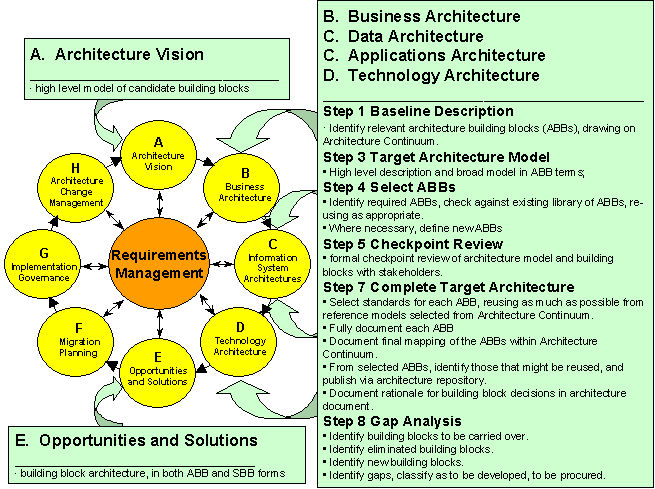
Principles Specification Process Levels of Modelling
This subsection focuses on the use of building blocks in the ADM. General considerations and characteristics of Building Blocks are described under Introduction to Building Blocks.
An architecture is a set of building blocks depicted in an architectural model, and a specification of how those building blocks are connected to meet the overall requirements of an information system.
The various building blocks in an architecture specify the services required in an enterprise-specific system.
There are some general principles underlying the use of building blocks in the design of specific architectures:
The process of identifying building blocks includes looking for collections of functions which require integration to draw them together or make them different:
In the early stages and during views of the highest level enterprise, the Building Blocks are often kept at a broad integration definition. It is during these exercises that the services definitions can often be best viewed. As implementation considerations are addressed, more detailed views of Building Blocks can often be used to address implementation decisions, focus on the critical strategic decisions or aid in assessing the value and future impact of commonality and reusability.
The process of building block definition takes place gradually as the Architecture Development Method is followed, mainly in Phases A, B, C, and D. It is an iterative process because as definition proceeds, detailed information about the functionality required, the constraints imposed on the architecture and the availability of products may affect the choice and the content of building blocks.
The key parts of the ADM at which building blocks are designed and specified are summarized below.
The major work in these steps consists of identifying the architectural building blocks (ABBs) required to meet the business goals and objectives. The selected set of ABBs is then refined in an iterative process to arrive at a set of Solution Building Blocks (SBBs) which can either be bought off the shelf or custom developed.
The specification of building blocks using the ADM is an evolutionary and iterative process. The key Phases and Steps of the ADM at which building blocks are evolved and specified are summarized below, and illustrated in Figure 1.
Figure 1: Key Phases / Steps of ADM at which Building Blocks are Evolved / Specified
In Phase A the earliest building block definitions start as relatively abstract entities within the Architecture Vision.
In Phases B, C, and D, building blocks within the Business, Data, Applications, and Technology Architectures are evolved to a common pattern of steps:
Finally in Phase E, Opportunities and Solutions, the building blocks become more implementation specific as Solution Building Blocks, and their interfaces become the detailed architecture specification. The output of Phase E is the building block architecture, both in Architectural (i.e. functionally defined) and Solution (i.e. product-specific) Building Block forms.
The minimum contents of an Architectural Building Block specification and a Solution Building Block specification are described under Introduction to Building Blocks.
Defining and developing the context for a set of building blocks takes place at two levels:
Defining and developing an actual set of building blocks also takes place at two levels:
Working through the four levels is an iterative process. Figure 2 shows how considerations at any level can result in change at any or all of the other levels.
Figure 2: Iteration between the Four Levels of Modeling
The business process level of definition takes place in Phases A and B of the ADM.
The technical functionality and constraints level work happens early in Phases B, C, and D, once the characteristics of the current system have been established. At that stage it is possible to identify the constraints imposed on new architecture work by the legacy of the old system (the baseline).
The architectural model and solution model levels consist of work done later in Phases B, C, and D, the Target Architecture steps of each phase, and Phase E, Opportunity Identification. The architectural model work is mostly done when taking different views of the architecture, and the solution model work in Phase E, where selection of products and projects takes place.
To show how building block definition happens in practice, the remainder of this appendix consists of a fictional worked example. In this fictional example much detail has been left out in order to emphasise the process.
Copyright � The Open Group, 1998, 2002, 2003